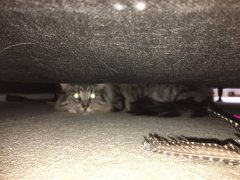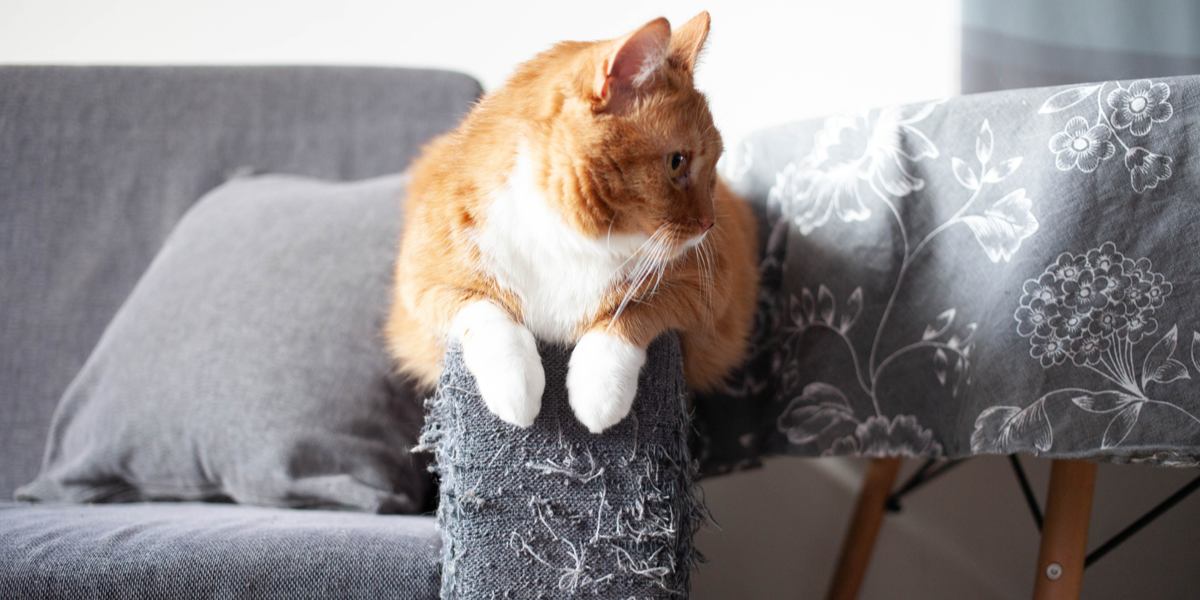
When cats scratch furniture or carpets, it can really damage your relationship with them. After all, you love your cat, but that sofa was expensive, and you want your deposit back on your rental!
It’s perhaps not a surprise, then, that around a quarter of cat owners want their cat to stop scratching the furniture, making it one of the most common behavioral issues in cats. Read on to find out why cats scratch the couch, the table, and other furniture, or tear holes in the wallpaper or your best rugs.
Also Read: How To Stop Cats From Scratching Furniture
3 Common Reasons Why Cats Scratch Furniture and Carpets
Understanding why cats scratch the furniture is the first step in preventing this behavior. Cats scratch for several reasons, each of which is a normal biological behavior.
1. Communication
The first, and thought to be main, reason that cats scratch is to leave signals to other cats. Cats have scent glands on their feet and between their toes, which leave pheromone messages that other cats can “read.”
Cats are not social creatures by nature, so scent-based signaling is a way that they can communicate without coming into contact with one another. In fact, the pheromones that cats leave when they’re scratching effectively say “this is my space, keep out”—it’s a territory marking behavior.
The combination of the unique pheromone and the visual signal of the scratches signals to other cats that they should find another territory. Your cat doesn’t know that the couch isn’t a good place to perform this behavior.
2. Claw Care
Cats also scratch to keep their claws in tip-top condition. As they scratch, the outer layers of the claw are pulled off. These outer layers are rough and can catch and cause pain or injury, so it’s important for cats to keep their claws in good condition. This also sharpens the claws, readying them for escape or defense as necessary.
3. Boredom
Your cat isn’t destroying furniture to punish you, or out of spite, but they might be more likely to scratch if they’re bored. The connection between boredom and stress is complex and boredom may increase stress, too.
Why Has My Cat Suddenly Started Scratching?
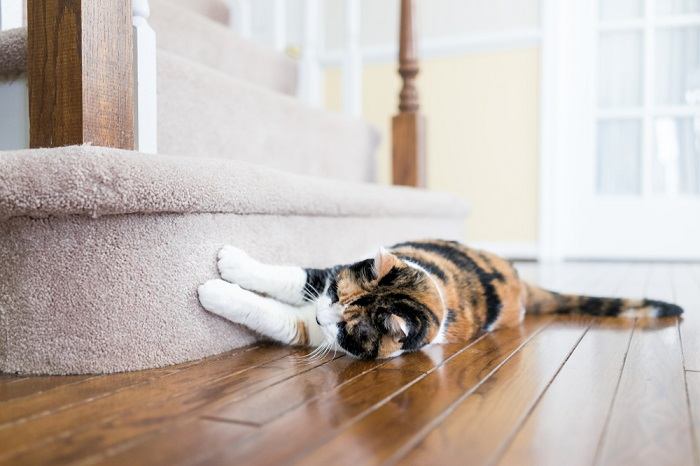
Cats have different scratching preferences. Some prefer scratching horizontally rather than vertically.
If your cat hasn’t been much of a scratcher in the past, you might be surprised if they’ve suddenly started scratching. What causes a cat to start scratching carpets if they’ve never been bothered before?
One possibility is that your cat feels an increased need to communicate their territory. This usually happens when a new cat arrives in the neighborhood, which may make your cat stressed. This is often accompanied by inappropriate toileting behavior.
Another reason why a cat may start scratching is that you’ve inadvertently removed their previous scratch post. Whether you thought they didn’t like their cat tree or you removed the garden fence, you might have accidentally removed their favorite scratching place, leaving them to find a new area.
New furniture can also cause scratching behavior to start. Whether this is because they’re marking the new furniture or because they like the texture of it to scratch on, it’s common for cats to start scratching new furniture. This is unfortunate, as doubtless, this is one of the most annoying behaviors for a cat to show and a major reason for cats to be declawed or given up for adoption.
Also Read: The 10 Best Scratching Posts
How To Stop Cats From Scratching Your Furniture?
Getting your cat to stop scratching the furniture is obviously a huge priority for anybody whose felines are destroying the sofa or carpets. So how do you train a cat not to scratch?
First, understand that this is a completely normal behavior for your cat. That means it’s very difficult to stop altogether, and you’ll have much more success if you try to redirect it.
The next thing to understand is that scratching may be driven by stress and anxiety. This means it’s pointless punishing them or telling them off as you may make matters worse.
1. Find Out Where Your Cat Is Scratching
Make note of the areas your cat scratches. Is it near a favorite sleeping spot? Or maybe it’s close to a window that looks out into the yard? Is it on a vertical or horizontal surface?
2. Look at the Scratching Post Situation
Do you have enough cat scratching posts for your cats? You should have a minimum of one per cat and one spare, so you might need to buy another scratching post. It’s estimated that around two-thirds of cat households don’t provide enough resources for all the cats in the family, with one-third of cats not having access to a scratching post.
For younger cats, rope or sisal is the preferred scratching surface, whereas senior cats often prefer carpet materials. Most cats prefer a vertical surface, but if your cat often scratches the carpet, try a horizontal scratcher instead.
A scratching post should be tall enough for your cat to stretch fully—about 3 feet tall—and sturdy enough that it won’t tip over when your cat is scratching.
3. Move Your Posts to Near Where Your Cat Is Already Scratching
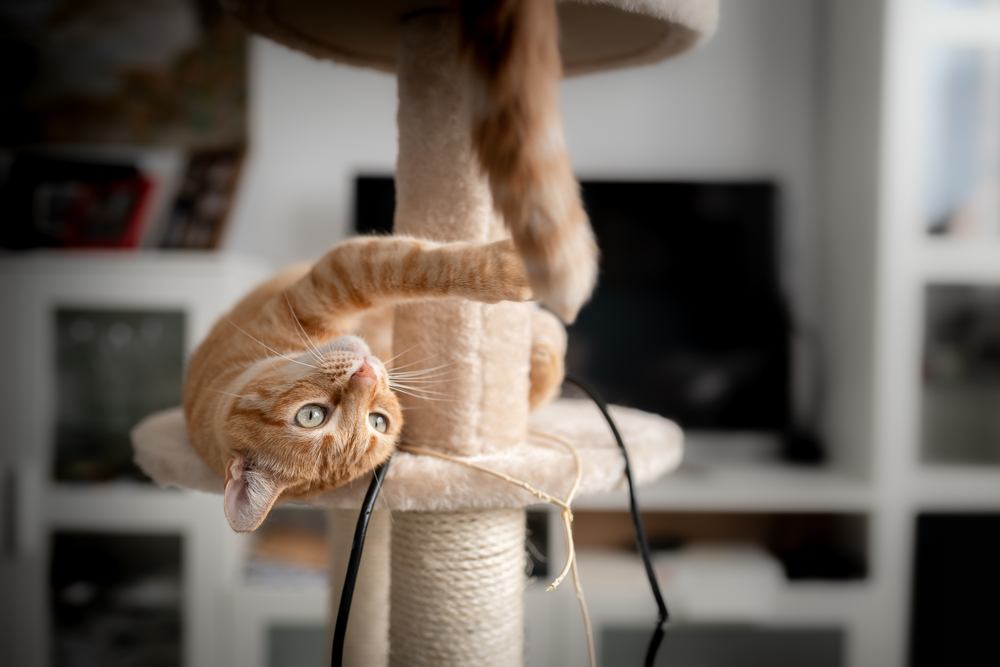
If your cat has a favorite scratching area, move a scratching post to the area. This is where your cat wants to mark their territory so let them—just not on the furniture! You can move the scratching post away from the area (slowly!) once they’re reliably using it, but for now, you need to go with it.
If you have other posts going unused around the house, consider moving them to see if this gets your cat interested. Cats often scratch after waking up, so try moving them close to a sleeping spot.
4. Make the Furniture or Carpet Less Enticing
You can also discourage your cat from scratching the furniture by covering over the scratch marks temporarily. The visual scratch marks act as a signal to the cat to start scratching, so covering them over may help your cat change their scratching spot from your best upholstery.
Some people recommend using double-sided sticky tape or other deterrents, but it’s best to check with a behaviorist before using these as it could make things worse.
5. Increase Your Cat’s Playtime
To alleviate boredom, increase your cat’s playtime by adding some more cat toys. Either make a mission to play with them daily, or use a food puzzle toy to get them to “hunt” their food, allowing them to display natural behaviors and use their brains.
This can mentally tire your cat out, as well as leave them feeling much more satisfied, and less likely to spend time worrying about territory.
Also Read: The 10 Best Cat Slow Feeders & Puzzle Feeders
6. Try Other Methods of Alleviating Anxiety
If your cat is nervous because of a new cat in the neighborhood or changes in the household, you might want to try other ways to alleviate their anxiety and prevent destructive scratching. Try providing plenty of hiding places, extra litter boxes, and a Feliway diffuser to help them feel confident in their territory.
How To Get a Cat To Use Their Scratching Post
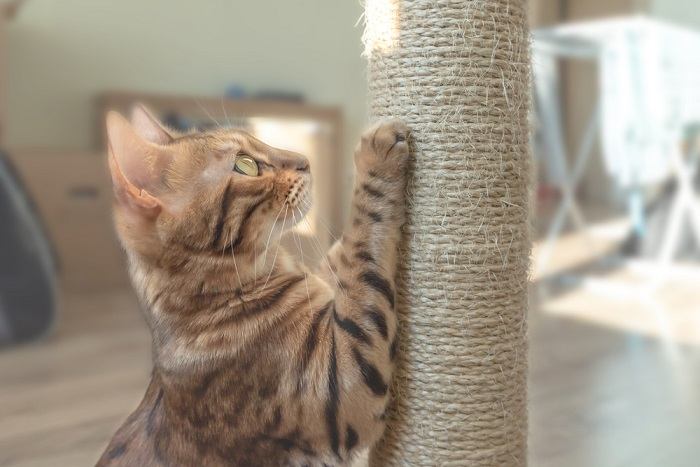
When introducing a new scratching post, try sprinkling it with a little catnip to draw your cat’s interest.
So now your cats have enough posts, and they’re in the right position, you need to encourage your cats to use them. Catnip is one way you might be able to do this—the smell of catnip treat causes some cats to scratch, so try applying it to the scratching post and see if it gets their attention.
There are also pheromone products designed to encourage cats to scratch their posts. These usually come in the form of liquids that you apply to the post. Because the post then smells like the interdigital pheromones (scratching pheromones) your cat is then encouraged to use it.
Lastly, some basic training can also help. Whenever your cat uses the post, give them praise and a treat. You can even use a clicker to “mark” the correct behavior (using the post) as cats can be clicker trained just like dogs!
Conclusion
Once you know why cats scratch furniture and carpets, it becomes easier to prevent this behavior. Providing plenty of scratching posts that are the right type and size is one of the best ways to help your cat scratch in a suitable place and not destroy your favorite couch.
However, if your cat continues to scratch furniture, you may want to consider calling a cat behaviorist for help.
Frequently Asked Questions
Do cats scratch to sharpen their claws?
Yes, cats do scratch to sharpen their claws, but they also scratch to communicate or as a way to relieve boredom.
Do all cat breeds scratch furniture?
All cat breeds feel the need to communicate and mark their territory, and for many cats, this means scratching furniture. There are no cat breeds that are guaranteed not to scratch furniture.
However, some breeds such as the Ragdoll are more easygoing, so it’s possible that a lower percentage of these cats will scratch. Unfortunately, nobody has studied this in detail.
Does trimming cat claws stop scratching?
Claw trimming may help your cat scratch less, but it’s unlikely to stop scratching altogether. Cats scratch for many reasons, and claw care is only one of them.
However, it’s worth trimming your cat’s nails regularly as it might reduce their scratching and it’s a good way of keeping an eye on the health of your cat’s paws.
Is it OK to declaw an indoor cat?
Declawing is a surgery where the ends of each toe, and the attached nails, are amputated. This means a cat has no claws. It used to be used as a way to prevent destruction of furniture, but is now not recommended, even for indoor cats.
Declawing causes a cat’s weight to be borne differently, causing early-onset arthritis. It’s also a painful procedure that creates no benefit to the cat, so it’s not in their best interest.
What are alternatives to declawing a cat?
Declawing is generally not recommended anymore, and it’s better to find alternatives such as training your cat, providing suitable outlets for their behavioral need to scratch, or even using claw covers or nail caps in the short term.
What is the best cat scratcher?
Every cat is different, so there’s no best cat scratcher. However, most cats favor a sisal rope vertical scratching post.

